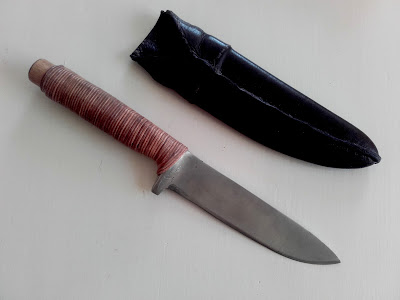You know how you've always wanted a "Bowie knife", or just a big knife for general camping use? Well I do, and having worked in an outdoor store I have a couple already, and they're really nice ones too. Why then make a new, crappy looking one.
Answer is simple, the new and shiny knife from the shop is expensive, and I might be the only one, but I'm a little afraid of damaging them, so I don't actually use them that much...
I was in a charity shop and found this knife for 2€, and thought "heck, so what if I ruin it trying".
This knife was slightly bent, but made of decent steel (most kitchen knives over 1 mm. thickness are today). So I bought it. Being a kitchen knife, it was also too big (big knives are good, but even that has a end). It's barely visible, but I've drawn a design on the knife blade. (You don't need one with a metal handle, wood is nicer, and you can always exchange a it for a home made new handle).
I took a hacksaw to it to get rid of the bigger bits, and was pleasantly surprised to break the hacksaw, indicating a nice hard blade on the knife. After I was done with the hacksaw I removed the rest of the unwanted blade with a grinder (making sure not to overheat the steel, bucket of water nearby is handy). If you don't have a grinder, a coarse wet stone will do. After a little fine tuning with a file, the knife was ready for the wet stone.
Now the knife is nice and sharp, and I need to come up with a way to make a sheath. I would also like to polish the knife, guess I'll do something with very fine sand paper or use some fabric with the dust from the wet stone as abrasive.
Knife is ~15 cm. now, a good length for most wood craft.
The sheath. I forgot to take a lot of pictures of the process, but you'll get the idea.
As this is mostly just to try it out, I just located the toughest wood we had. Some hardwood would be better, but plywood is glued from lots of layers, making stiffer and less prone to moisture damage. I chose a wood sheath, as I did not have any leather of a suitable thickness to make a wrap around sheath. Plywood turned out to be a good choice, one can take of one of the layers at a time, providing an easier way of making even knife shaped hole in the wood. (This is the step you need to imagine).
The sheath is made from two pieces of wood, each with a blade shaped hole in it. These two are glued together to form the sheath.
I'm a big fan of leather for this kind of stuff, so I fashioned some leather to wrap around the wooden sheath. This leather is too thin and soft to function as a sheath in it's own right. The top part, where the belt loop is, is a double layer that ends at the stitch going across the sheath. The rest is a single layer of leather, suede side in, wrapped around the wooden sheath, and pulled tight with stitching.
You can just see the wooden insert into the leather wrapping, and the belt loop as a simple hole in the double leather at the top part.
I'm really looking forward to trying this out in the wild. My hopes are that the leather will protect the wood from the wet, while the wood will provide a snug home for the knife.
At this point, I'm a little bit sad I didn't get a knife with a wooden handle, but that's for another time!
Update!









No comments:
Post a Comment